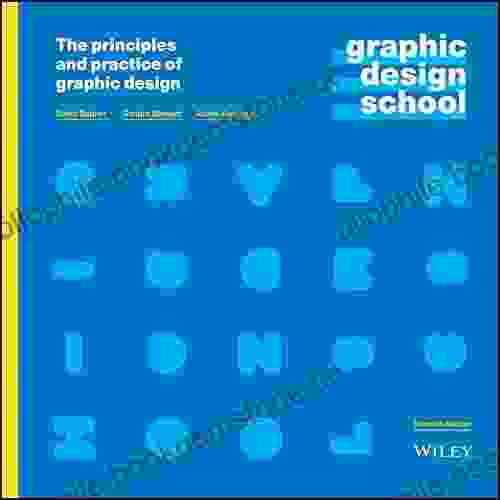Graphic Design School: The Principles And Practice Of Graphic Design

Graphic design is a multi-faceted field that encompasses a wide range of skills and techniques. It involves the visual communication and presentation of ideas, information, and emotions through the skillful use of typography, imagery, color, and composition. In this comprehensive guide, we will delve into the principles and practice of graphic design, providing aspiring designers with a solid foundation in the subject.
Understanding the Fundamentals of Graphic Design
Elements of Design: The building blocks of graphic design include lines, shapes, textures, and colors. Each element possesses unique characteristics that can evoke different emotions and convey specific messages.
Design Principles: These principles guide the arrangement and organization of design elements. They include balance, contrast, harmony, proximity, and repetition. By applying these principles, designers create visually appealing and functional designs.
Graphic Design School: The Principles and Practice of Graphic Designby Sandra Stewart4.4 out of 5
Language : English File size : 59690 KB Text-to-Speech : Enabled Screen Reader : Supported Enhanced typesetting : Enabled Print length : 206 pages Lending : Enabled Typography: The art of arranging and setting typefaces is crucial in graphic design. Understanding typefaces, their characteristics, and how to use them effectively enhances communication and readability.
Color Theory: Colors play a vital role in graphic design, conveying emotions, creating visual interest, and guiding the viewer's attention. Designers must master color theory to harness its communicative power.
The Design Process: From Concept to Execution
Concept Development: The first stage involves understanding the design brief, researching the topic, and generating ideas that align with the project's goals.
Sketching and Ideation: Designers use sketches and rough layouts to explore and refine their concepts, experimenting with different compositions and visual elements.
Digital Creation and Refinement: Once the concept is finalized, designers use digital tools such as Adobe Photoshop, Illustrator, and InDesign to create and refine their designs.
Prototyping and Testing: Prototypes and mockups allow designers to test the effectiveness of their designs and gather feedback before finalizing production.
Typography: The Art of Communicating with Type
Typefaces and Their Classifications: Understanding the different typefaces and their classifications (Serif, Sans Serif, Display Type, etc.) helps designers select the appropriate typefaces for their projects.
Hierarchy and Readability: Typography involves establishing a visual hierarchy to guide the reader's eye through a design. Designers use font size, weight, and style to create emphasis and improve readability.
Kerning and Tracking: Kerning and tracking are techniques used to adjust the spacing between letters and lines, respectively. Proper use of these techniques enhances readability and visual appeal.
Grid Systems: Grid systems provide a structured framework for organizing and aligning design elements, ensuring consistency and visual harmony.
Color Theory: Harnessing the Power of Hues
Color Models: Understanding color models, such as RGB, CMYK, and Pantone, is essential for color matching and consistency across different platforms and print media.
Color Schemes: Designers use color schemes to create harmonious and effective color combinations. Common schemes include monochromatic, analogous, and complementary.
Color Psychology: Colors evoke distinct emotions and convey different meanings. Designers leverage color psychology to influence the viewer's perception and behavior.
Color Contrast and Accessibility: Designers must consider color contrast and accessibility to ensure that their designs are inclusive and easily accessible to all users, regardless of visual impairments.
Graphic Design in the Digital Age
Web Design: Web design focuses on creating user-friendly and visually appealing websites that provide an optimal user experience across various devices and platforms.
UI/UX Design: User interface (UI) and user experience (UX) design involve designing interfaces that are intuitive, functional, and enjoyable for users to interact with.
Motion Graphics: Motion graphics bring movement and animation to graphic design, creating engaging and immersive experiences for viewers.
Social Media Graphics: Social media graphics are designed specifically for various social media platforms and aim to capture attention, convey messages, and drive engagement.
Ethical Considerations in Graphic Design
Copyright and Intellectual Property: Designers must respect copyright laws and properly attribute original works to avoid plagiarism and legal consequences.
Cultural Sensitivity: Graphic designers have a responsibility to be culturally sensitive and avoid perpetuating stereotypes or offensive imagery.
Environmental Sustainability: Designers can contribute to environmental sustainability by using eco-friendly materials and practices in their work.
Social Responsibility: Graphic design can be used to promote social causes, raise awareness, and make a positive impact on society.
The principles and practice of graphic design encompass a vast body of knowledge and skills. By mastering the elements of design, understanding the design process, harnessing the power of typography and color theory, and embracing ethical considerations, aspiring designers can create visually stunning, effective, and meaningful designs that communicate, inspire, and captivate audiences. As the field of graphic design continues to evolve, designers must remain adaptable, embrace new technologies, and stay abreast of emerging trends to stay relevant and effective in this competitive industry.
4.4 out of 5
| Language | : | English |
| File size | : | 59690 KB |
| Text-to-Speech | : | Enabled |
| Screen Reader | : | Supported |
| Enhanced typesetting | : | Enabled |
| Print length | : | 206 pages |
| Lending | : | Enabled |
Do you want to contribute by writing guest posts on this blog?
Please contact us and send us a resume of previous articles that you have written.
 Best Book
Best Book Page Flip
Page Flip Bookshelf
Bookshelf Literary loom
Literary loom Chapter
Chapter Bookish
Bookish PageTurner
PageTurner Bibliophile
Bibliophile Story
Story Inkwell
Inkwell Bookworm
Bookworm Labyrinth
Labyrinth Plot Twist
Plot Twist Prose
Prose Paperback
Paperback Storyteller
Storyteller Sanctuary
Sanctuary Fiction
Fiction Reading
Reading Chronicle
Chronicle Read
Read Rick Steves
Rick Steves Neema Avashia
Neema Avashia Richard Poulin
Richard Poulin Robin Landa
Robin Landa Paris Permenter
Paris Permenter Gerald Sorin
Gerald Sorin Vic Costello
Vic Costello Donna Rifkind
Donna Rifkind Tobie S Stein
Tobie S Stein Jean Claude Baker
Jean Claude Baker Tabakmann
Tabakmann H G Wells
H G Wells Mark Harlan
Mark Harlan Greg Montego
Greg Montego Merri Melde
Merri Melde Rough Guides
Rough Guides Janwillem Vandewetering
Janwillem Vandewetering Meriel Thurstan
Meriel Thurstan Logan Ryles
Logan Ryles Helen Burstyn
Helen Burstyn Zondervan
Zondervan Zane Grey
Zane Grey Robert Hughes
Robert Hughes Paul Oldfield
Paul Oldfield Nichole Ashlyn Jackson
Nichole Ashlyn Jackson Lisa Mulcahy
Lisa Mulcahy Ian King
Ian King Michael Hulse
Michael Hulse Steve Roberts
Steve Roberts Joseph Heywood
Joseph Heywood Yingjin Zhang
Yingjin Zhang Hannu Rajaniemi
Hannu Rajaniemi Jean Hugard
Jean Hugard Roland Betancourt
Roland Betancourt Sydney L Iaukea
Sydney L Iaukea Peter Hopkirk
Peter Hopkirk Nikki Mcclure
Nikki Mcclure Haidee Jo Summers
Haidee Jo Summers Peter Canellos
Peter Canellos Larry D Ellis
Larry D Ellis Martina Nohl
Martina Nohl Karin Slaughter
Karin Slaughter J Malcolm Garcia
J Malcolm Garcia Michael J Arlen
Michael J Arlen Indy Quillen
Indy Quillen Mark Doty
Mark Doty Mimi Kwa
Mimi Kwa Cj Fentiman
Cj Fentiman Jonathan Ned Katz
Jonathan Ned Katz Roxanne Dunbar Ortiz
Roxanne Dunbar Ortiz Judy Batalion
Judy Batalion Helen Hoang
Helen Hoang Gayle Bird
Gayle Bird Tw Robinson
Tw Robinson Grace Lee Boggs
Grace Lee Boggs Liz Scotta
Liz Scotta Kit Thornton
Kit Thornton Iris Murdoch
Iris Murdoch Ginger Lawrence
Ginger Lawrence Susie Nash
Susie Nash Max Wilk
Max Wilk Sebastian Smee
Sebastian Smee Morr Meroz
Morr Meroz Kimberly A Whitler
Kimberly A Whitler Heather Murdock
Heather Murdock Global Baby Care
Global Baby Care Gail Pallin
Gail Pallin William Boyd
William Boyd Susan Donnell
Susan Donnell Cathy Johnson
Cathy Johnson M S Holm
M S Holm R L Giddings
R L Giddings Helen Cates
Helen Cates Kimberla Lawson Roby
Kimberla Lawson Roby Sunil Tanna
Sunil Tanna Sonora Carver
Sonora Carver Rinoz
Rinoz Kiyo Sato
Kiyo Sato Sallie Ketcham
Sallie Ketcham James Willard Schultz
James Willard Schultz Nicole Falls
Nicole Falls J Susan Corley
J Susan Corley Rachel Schreiber
Rachel Schreiber Joseph L Scarpaci
Joseph L Scarpaci Jay A Stout
Jay A Stout Christopher Butler
Christopher Butler Kurt Meissner
Kurt Meissner Gabriella Guglielminotti Trivel
Gabriella Guglielminotti Trivel Monona Rossol
Monona Rossol Vanja Hamzic
Vanja Hamzic S L Rowland
S L Rowland Ian Olio
Ian Olio Bella Blair
Bella Blair Rachel Berenson Perry
Rachel Berenson Perry Marla Day Fitzwater
Marla Day Fitzwater Jerry Shepard
Jerry Shepard J A Rogers
J A Rogers John Wooley
John Wooley Werner Stejskal
Werner Stejskal Matt Hranek
Matt Hranek Lisa Strattin
Lisa Strattin Sahera Patel
Sahera Patel Sam Magavern
Sam Magavern Neil Gaiman
Neil Gaiman Tom Wheeler
Tom Wheeler Robert Mads Anderson
Robert Mads Anderson Gunnar Staalesen
Gunnar Staalesen Jonathan P Brazee
Jonathan P Brazee Kay Redfield Jamison
Kay Redfield Jamison William Mcinnes
William Mcinnes Heidi Moksnes
Heidi Moksnes Jakob Tanner
Jakob Tanner Simone Edwards
Simone Edwards Yaakov Yanky Greenspan
Yaakov Yanky Greenspan Jake Bible
Jake Bible P Z Walker
P Z Walker John Canemaker
John Canemaker Sara El Sayed
Sara El Sayed Robert O Harder
Robert O Harder Harry Turtledove
Harry Turtledove Nathaniel Flakin
Nathaniel Flakin Tu Ilape Vimahi
Tu Ilape Vimahi Roger Housden
Roger Housden Gubba
Gubba Jen Finelli
Jen Finelli The Dancing Pages Publishing House
The Dancing Pages Publishing House Polly Mckenna Cress
Polly Mckenna Cress Toni Petniunas
Toni Petniunas Mark Anthony Rolo
Mark Anthony Rolo Len Lawson
Len Lawson Lucy Worsley
Lucy Worsley Henry Hongmin Kim
Henry Hongmin Kim Sarah Sofia Granborg
Sarah Sofia Granborg Margo Bond Collins
Margo Bond Collins Winston S Churchill
Winston S Churchill Ilka Hammer
Ilka Hammer Joanne Sharpe
Joanne Sharpe Nick Middleton
Nick Middleton Kal Wagenheim
Kal Wagenheim Gloria Fossi
Gloria Fossi Paul Theroux
Paul Theroux Heinz Peter Wagner
Heinz Peter Wagner Mike Shepherd
Mike Shepherd Kathleen James Chakraborty
Kathleen James Chakraborty Gennaro Contaldo
Gennaro Contaldo Carolyn Phillips
Carolyn Phillips Lizzy Bequin
Lizzy Bequin Tyler Farnham
Tyler Farnham Tom Kidd
Tom Kidd John Seed
John Seed John La Farge
John La Farge Pat Mcleod
Pat Mcleod Thomas R Lindlof
Thomas R Lindlof Kimberly Brooks
Kimberly Brooks Orla Kiely
Orla Kiely Steve Lyons
Steve Lyons Marie D Jones
Marie D Jones Tilda Balsley
Tilda Balsley Philip Steadman
Philip Steadman Gavin Menzies
Gavin Menzies Gregory Maguire
Gregory Maguire Nathan Mccall
Nathan Mccall Catharine Slade Brooking
Catharine Slade Brooking Greg Simonds
Greg Simonds Stephen Fraser
Stephen Fraser Jeanne Cooper
Jeanne Cooper Kimora Lee Simmons
Kimora Lee Simmons Unique Journal
Unique Journal Nalo Hopkinson
Nalo Hopkinson Harlan Hogan
Harlan Hogan Masakazu Ishikawa
Masakazu Ishikawa Jennifer J Baumgartner
Jennifer J Baumgartner Sam Gennawey
Sam Gennawey Sonya Curry
Sonya Curry Bradford Bates
Bradford Bates Ross Anderson
Ross Anderson Tetsuko Kuroyanagi
Tetsuko Kuroyanagi Viola Grace
Viola Grace K Stephen Prince
K Stephen Prince Brian Patton
Brian Patton John Barnes
John Barnes Christopher R Cox
Christopher R Cox Hal Rubenstein
Hal Rubenstein Roger Winter
Roger Winter Patrick Lange
Patrick Lange Gina Dejesus
Gina Dejesus Vine Aduara
Vine Aduara Jenefer Robinson
Jenefer Robinson Oleg Senkov
Oleg Senkov Candice Lau
Candice Lau Mark Evanier
Mark Evanier John D Macdonald
John D Macdonald Karen Traviss
Karen Traviss Stephanie Storey
Stephanie Storey Blue Knight
Blue Knight Grif Stockley
Grif Stockley Wolfgang Riebe
Wolfgang Riebe M K Eidem
M K Eidem Keith Brymer Jones
Keith Brymer Jones Thomas Wolf
Thomas Wolf Harold Speed
Harold Speed Katie Dowe
Katie Dowe Jonathan Brooks
Jonathan Brooks Reyna Grande
Reyna Grande Leslie J Sherrod
Leslie J Sherrod Margaret Randall
Margaret Randall Jerry Yarnell
Jerry Yarnell Kim Heinbuch
Kim Heinbuch Black Rose
Black Rose Steve Cohen
Steve Cohen J G Heck
J G Heck Rebekah J Kowal
Rebekah J Kowal Maggie March
Maggie March Saxon Andrew
Saxon Andrew John L Williams
John L Williams Rosie Rosenzweig
Rosie Rosenzweig Tawana
Tawana Viktorija Todorovska
Viktorija Todorovska Isadora Duncan
Isadora Duncan Anne Marie Paquet Deyris
Anne Marie Paquet Deyris George R R Martin
George R R Martin Gabrielle Union
Gabrielle Union David Leddick
David Leddick Guisela Latorre
Guisela Latorre James D Keyser
James D Keyser Octavia E Butler
Octavia E Butler Skye Mackinnon
Skye Mackinnon Gerald M Kilby
Gerald M Kilby Guillermo Del Toro
Guillermo Del Toro Dallas Shaw
Dallas Shaw Sandy Mitchell
Sandy Mitchell Renae Anderson
Renae Anderson Charles Gorham
Charles Gorham Jen Carter
Jen Carter Gail Thorell Schilling
Gail Thorell Schilling Joseph Labrecque
Joseph Labrecque Jean Claude Ellena
Jean Claude Ellena Jan Strickland
Jan Strickland Harry Feeney
Harry Feeney James O Barr
James O Barr Jay Roeder
Jay Roeder Joyce Maynard
Joyce Maynard Simon Proudman
Simon Proudman Jim Gertz
Jim Gertz Clayton M Rines
Clayton M Rines E Train Learning
E Train Learning Laird Barron
Laird Barron Judy Cook
Judy Cook Paul Wells
Paul Wells Gordon Doherty
Gordon Doherty Joseph Luzzi
Joseph Luzzi Jean Pierre Sylvestre
Jean Pierre Sylvestre Casey Watson
Casey Watson Michael Oren Fitzgerald
Michael Oren Fitzgerald Victoria Abbott Riccardi
Victoria Abbott Riccardi Brenda Cooper
Brenda Cooper Nancy J Morris
Nancy J Morris Liz Lerman
Liz Lerman Johnny B Truant
Johnny B Truant Ray Daniels
Ray Daniels Paul Benedict Rowan
Paul Benedict Rowan Rose Edin
Rose Edin David Sobotta
David Sobotta Sharon C Cooper
Sharon C Cooper Billy Pegram
Billy Pegram Aubrey Beardsley
Aubrey Beardsley Kayla Machine
Kayla Machine Sam Kashner
Sam Kashner Paul Wallis
Paul Wallis Henry Warren
Henry Warren Harriet Beecher Stowe
Harriet Beecher Stowe Glen Gavin
Glen Gavin Tiffany Jenkins
Tiffany Jenkins Lucy Grealy
Lucy Grealy John Muir Laws
John Muir Laws Rick Partlow
Rick Partlow Sujatha Gidla
Sujatha Gidla Ndeye Labadens
Ndeye Labadens Hannes Rall
Hannes Rall David Rapp
David Rapp Graham Rowley
Graham Rowley Bill Bryson
Bill Bryson Ted Seth Jacobs
Ted Seth Jacobs Ruth Collis
Ruth Collis Sherman Alexie
Sherman Alexie Maxwell Farmer
Maxwell Farmer Larry Schroeder
Larry Schroeder Nathan Johnson
Nathan Johnson Simu Liu
Simu Liu Malcolm C Salaman
Malcolm C Salaman Leigh Bardugo
Leigh Bardugo William A Kappele
William A Kappele Judy Tzu Chun Wu
Judy Tzu Chun Wu Ryan Debruyn
Ryan Debruyn Sylvie Covey
Sylvie Covey Theo Fennell
Theo Fennell Judi Whitton
Judi Whitton Ja Nese Dixon
Ja Nese Dixon Ben Box
Ben Box Tayari Jones
Tayari Jones Leo Tolstoy
Leo Tolstoy Hannah Hinchman
Hannah Hinchman Warren Olson
Warren Olson Judith Pearson
Judith Pearson Helen Wilkie
Helen Wilkie Julien Gorbach
Julien Gorbach Harry Bernstein
Harry Bernstein Kerry Duncan
Kerry Duncan Olivia Gaines
Olivia Gaines Jonathan Nevair
Jonathan Nevair Luigi Lanzi
Luigi Lanzi Gary Greene
Gary Greene Gene Luen Yang
Gene Luen Yang Carl Weber
Carl Weber Shari Lapena
Shari Lapena Lisa Harris
Lisa Harris Robert Elms
Robert Elms Riley Sager
Riley Sager Gregg Kreutz
Gregg Kreutz Bianca Del Rio
Bianca Del Rio David Carrier
David Carrier Scott Lunt
Scott Lunt Grant Fuller
Grant Fuller Julius Schnorr Von Carolsfeld
Julius Schnorr Von Carolsfeld Susan Hardman Moore
Susan Hardman Moore Helen Birch
Helen Birch J Pal
J Pal Ta Nehisi Coates
Ta Nehisi Coates William C Rempel
William C Rempel Lucy Coleman
Lucy Coleman Jessica Pan
Jessica Pan Ian Coleman
Ian Coleman N Scott Momaday
N Scott Momaday Jayne Shrimpton
Jayne Shrimpton Colin Thubron
Colin Thubron Jon Nelson
Jon Nelson Megan Wells
Megan Wells Rich Polanco
Rich Polanco Jonathan Chapman
Jonathan Chapman Sandra A Krasovec
Sandra A Krasovec Heidi Ardizzone
Heidi Ardizzone Mike Chaplin
Mike Chaplin Dana Tenzler
Dana Tenzler Syd Field
Syd Field Gerald Durrell
Gerald Durrell Bob Spitz
Bob Spitz Jonathan White
Jonathan White Jaquavis Coleman
Jaquavis Coleman Debra Gwartney
Debra Gwartney Mark C Taylor
Mark C Taylor David Brin
David Brin Garance Dore
Garance Dore Victoria H Smith
Victoria H Smith Shimon Redlich
Shimon Redlich Tracy Kidder
Tracy Kidder Laura Boswell
Laura Boswell Tom Clancy
Tom Clancy Jan V White
Jan V White John Lewis
John Lewis Michael Cawood
Michael Cawood Geoff Saunders
Geoff Saunders Michael Shea
Michael Shea Harmon Cooper
Harmon Cooper Greg Albert
Greg Albert The Total Travel Guide Company
The Total Travel Guide Company Jennifer Criswell
Jennifer Criswell Kyle Chayka
Kyle Chayka Jonathan D Spence
Jonathan D Spence Vivienne Westwood
Vivienne Westwood George Mather
George Mather Billy Showell
Billy Showell Lou Schreiber
Lou Schreiber David Schwartz
David Schwartz Lucius Shepard
Lucius Shepard Greg Iles
Greg Iles Jim Schutze
Jim Schutze Peter F Hamilton
Peter F Hamilton Will Jordan
Will Jordan Simon Tam
Simon Tam Piper Kerman
Piper Kerman S L Giger
S L Giger Richard Sayette
Richard Sayette Sandra Stewart
Sandra Stewart Glenn Alterman
Glenn Alterman Godfree Roberts
Godfree Roberts Marilyn Grant
Marilyn Grant Andreas Marks
Andreas Marks Pat Spooner
Pat Spooner H Beam Piper
H Beam Piper H Robert Charles
H Robert Charles Rae Morris
Rae Morris Robert Asprin
Robert Asprin Kyle Mills
Kyle Mills Giuseppe Leonardi
Giuseppe Leonardi Vasanth Simon
Vasanth Simon Rachel Baker
Rachel Baker H Peter Alesso
H Peter Alesso Scott Ryan
Scott Ryan Gianrico Carofiglio
Gianrico Carofiglio Geoffrey Corfield
Geoffrey Corfield Randolph Lalonde
Randolph Lalonde Jan Steinbright
Jan Steinbright James Lawson
James Lawson Gilbert King
Gilbert King Gary W Gallagher
Gary W Gallagher Marita Golden
Marita Golden Fred Moten
Fred Moten Lingo Mastery
Lingo Mastery Naomi Duguid
Naomi Duguid Heather Morgan
Heather Morgan Gordon Allard
Gordon Allard Timothy Ellis
Timothy Ellis Karen Taborn
Karen Taborn Vincent Lenihan
Vincent Lenihan Tad Williams
Tad Williams Linda Holtzschue
Linda Holtzschue January Bell
January Bell M D Cooper
M D Cooper Robert Farris Thompson
Robert Farris Thompson General
General Keisha J
Keisha J Jeanine Kitchel
Jeanine Kitchel William Walker Atkinson
William Walker Atkinson Jennifer Worth
Jennifer Worth Jonquil Graham
Jonquil Graham Rochelle Alers
Rochelle Alers Pam Flowers
Pam Flowers George W Bush
George W Bush Marcel Proust
Marcel Proust Robert Sinnerbrink
Robert Sinnerbrink George H Gisser
George H Gisser Joanie Holzer Schirm
Joanie Holzer Schirm Terry Harrison
Terry Harrison Lisa Dines
Lisa Dines M G Herron
M G Herron Ben Philippe
Ben Philippe Remy Stern
Remy Stern Ginger Booth
Ginger Booth Joe Jackson
Joe Jackson Robert Shufflebotham
Robert Shufflebotham Shantanu Naidu
Shantanu Naidu J B Turner
J B Turner Gianni Simone
Gianni Simone Oscar Wilde
Oscar Wilde Justin Mccurry
Justin Mccurry Ivan Margolius
Ivan Margolius George Kubler
George Kubler Dima Zales
Dima Zales Hubert Allcock
Hubert Allcock Ellen Tomaszewski
Ellen Tomaszewski Luke Sullivan
Luke Sullivan Gayle Rosengren
Gayle Rosengren Megan Fairchild
Megan Fairchild Erin H Turner
Erin H Turner Margaret Coel
Margaret Coel Jennifer D Walker
Jennifer D Walker Shane Lambert
Shane Lambert Roger Kimball
Roger Kimball Thomas Lockwood
Thomas Lockwood Mickey Zucker Reichert
Mickey Zucker Reichert Helena Reckitt
Helena Reckitt Yayoi Kusama
Yayoi Kusama Yaa Gyasi
Yaa Gyasi Kim Brown Seely
Kim Brown Seely Polly Barton
Polly Barton Spike Bucklow
Spike Bucklow Lyn Barrett
Lyn Barrett Jack Higgins
Jack Higgins Thomas Dublin
Thomas Dublin Hooman Majd
Hooman Majd Steven Watts
Steven Watts Nick Webb
Nick Webb Peter Matthiessen
Peter Matthiessen Steven D Wolf
Steven D Wolf Doug Gelbert
Doug Gelbert Rebecca Zanetti
Rebecca Zanetti Robert Mccammon
Robert Mccammon James Fox
James Fox Robert Kunstaetter
Robert Kunstaetter Patrick Leigh Fermor
Patrick Leigh Fermor Gill Barron
Gill Barron Helena Hunt
Helena Hunt M Angela Sanders
M Angela Sanders Manny Serrato
Manny Serrato Julien Blanc Gras
Julien Blanc Gras Gary Troia
Gary Troia Richard Dunlop
Richard Dunlop Jim Carpenter
Jim Carpenter Rebecca Atwood
Rebecca Atwood Greater Than A Tourist
Greater Than A Tourist Joseph Sheppard
Joseph Sheppard Hans Von Trotha
Hans Von Trotha Gordon Mackenzie
Gordon Mackenzie Maksim Goldenshteyn
Maksim Goldenshteyn Wendy Hollender
Wendy Hollender Jen Turano
Jen Turano Lee Summers
Lee Summers Mariah Carey
Mariah Carey Lawrence Grobel
Lawrence Grobel Mary E Davis
Mary E Davis W Michael Gear
W Michael Gear Gb Tran
Gb Tran Mark Bergin
Mark Bergin Morris Rossabi
Morris Rossabi Mike Ashley
Mike Ashley Theodora Goss
Theodora Goss Giannalberto Bendazzi
Giannalberto Bendazzi Stanley C Jenkins
Stanley C Jenkins Jimmy Clay
Jimmy Clay Katharine Gregorio
Katharine Gregorio Joanne Fluke
Joanne Fluke Naima Coster
Naima Coster Rosanne Knorr
Rosanne Knorr Tasha Oren
Tasha Oren Garner Simmons
Garner Simmons Susan Zwerman
Susan Zwerman Tung Nguyen
Tung Nguyen Linda Cooper Bowen
Linda Cooper Bowen Justin Taylor
Justin Taylor Marlene Blessing
Marlene Blessing Thomas A Kelly
Thomas A Kelly Grey King
Grey King Michael Z Williamson
Michael Z Williamson Robert Charles Wilson
Robert Charles Wilson Gav Thorpe
Gav Thorpe David Ogilvy
David Ogilvy Kristal Norton
Kristal Norton Tom Coffman
Tom Coffman Paul Levitz
Paul Levitz Kyle Kirrin
Kyle Kirrin B V Larson
B V Larson Jonathon Keats
Jonathon Keats Eden Robinson
Eden Robinson Stephen Malins
Stephen Malins Henry Bond
Henry Bond Sarah Helm
Sarah Helm K Kris Loomis
K Kris Loomis Gil Mcneil
Gil Mcneil Jonathan Moeller
Jonathan Moeller Heather D Ward
Heather D Ward Dean Koontz
Dean Koontz Dr Will Taegel
Dr Will Taegel Joi Barrios
Joi Barrios Sarah Cortez
Sarah Cortez Valerie David
Valerie David Ian K Smith
Ian K Smith Jamie Davis
Jamie Davis Diz White
Diz White Jeremy Hicks
Jeremy Hicks Gail Morin
Gail Morin Cap Daniels
Cap Daniels Irmgard Weitlaner Johnson
Irmgard Weitlaner Johnson Bradford Pearson
Bradford Pearson Sara Ivy Hill
Sara Ivy Hill Shameek Speight
Shameek Speight Justine Cowan
Justine Cowan Rachel Simon
Rachel Simon Mona Golabek
Mona Golabek
Light bulbAdvertise smarter! Our strategic ad space ensures maximum exposure. Reserve your spot today!

 F. Scott FitzgeraldFrom Tranquility to Enlightenment: Immersive Experiences in a Japanese Zen...
F. Scott FitzgeraldFrom Tranquility to Enlightenment: Immersive Experiences in a Japanese Zen... Alexander BlairFollow ·18.7k
Alexander BlairFollow ·18.7k Joe SimmonsFollow ·7.6k
Joe SimmonsFollow ·7.6k Austin FordFollow ·15.1k
Austin FordFollow ·15.1k Adrien BlairFollow ·4.7k
Adrien BlairFollow ·4.7k Shaun NelsonFollow ·8.1k
Shaun NelsonFollow ·8.1k Darrell PowellFollow ·18.6k
Darrell PowellFollow ·18.6k Edison MitchellFollow ·4.4k
Edison MitchellFollow ·4.4k Duane KellyFollow ·16.9k
Duane KellyFollow ·16.9k

 Scott Parker
Scott ParkerIn Her Own Words, In Their Own Words: A Journey of...
In Her Own Words, In...

 Colin Richardson
Colin RichardsonYou Don't Have to Say You Love Me: A Lyrical Journey...
In the annals of popular music,...

 Clark Campbell
Clark CampbellThe Enthralling Narrative of John Tanner, the Falcon: A...
The Man, the...

 Glenn Hayes
Glenn HayesThe Wolf Hour: A Spine-Tingling Thriller that Unravels...
Synopsis Prepare...

 Thomas Mann
Thomas MannThe Pirate Tribulation: A Literary Masterpiece Exploring...
Setting Sail into the...

 Eugene Powell
Eugene PowellEscape The Rat Race And Live Life As An Expat
How to find a job abroad If you're...
4.4 out of 5
| Language | : | English |
| File size | : | 59690 KB |
| Text-to-Speech | : | Enabled |
| Screen Reader | : | Supported |
| Enhanced typesetting | : | Enabled |
| Print length | : | 206 pages |
| Lending | : | Enabled |








